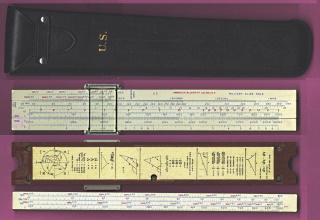
American Blueprint Military Slide Rule
ISRM 14.09.21.04
|
American Blueprint Military Slide Rule Version 1
Made in USA - by K&E for American Blueprint (Military contractor)
Front Scale:
Opposite Angle Deg, Mils [Apex Angle) Mils, Deg, CI,C (Base)] D (Range),A
Back Scale: [Tan, Sin-Tan, Tan ]
Back: Geometry formulae
Gift Of Edward Wright, Texas.
 TM 6-240 Manual 3.35MB Pdf
TM 6-240 Manual 3.35MB Pdf
Field Artillery Military Slide Rule
|

American Blueprint Military Slide Rule
ISRM 22.07.06.50
|
American Blueprint Military Slide Rule Version 2
Made in USA - by K&E for American Blueprint (Military contractor)
Front Scale:
Opposite Angle Deg, Mils [Apex Angle) Mils, Deg, CI,C (Base)] D (Distance),A
Back Scale: [Tan, Sin-Tan, Tan ]
Back: Geometry formulae
Note: D scale "Range" changed to "Distance".
Gift Of Cindy Tate, Bozeman, Montana.

|

D&P (Aristo) German Gr.W.34 Artillery Ranging (1943)
ISRM 18.09.17.21
|
D&P (Aristo) German Gr.W.34 Artillery Ranging Slide Rule (gwr Marz 1943, March, 1943)
Made in Germany by Dennert & Pape (Aristo)
Front Scales:
W1 Erhohung(Elevation), E1 Entfernung(Range)
[ G1, G2 Geländewinkel(angle of error in landing point ) ]
W2 Erhohung(Elevation), E2 Entfernung(Range), S Flugzeit(time of flight)
Back Slide: [ G3 Geländewinkel a fur Flugzeit Aufsatzwinkel (angle at top of flight parabola) ]
MarksFace: gwr Marz 1943 - se. Gr. W. 34 - Nur fur den Dienstgebrauch!
Reverse: Instructions for use
Gift of Donald J. Bachelor Collection
Note: This specimen was used during WWII and was brought back to the U.S.A. by Colonel in Patten's Army in Stuttgart, Germany

|

D&P (Aristo) German GWR Artillery Ranging
ISRM 22.10.15.01
|
D&P (Aristo) German GWR Artillery Ranging Slide Rule
Made in Germany.. "GWR" reveals that this was manufactured by Dennert & Pape for the German Wehrmacht.
Front Scales:
EM, Gerätekonst, Ablage in Winkelsekunden [ Ablage in m, Wehre e in hm ] Gerätekonstante
Reverse: (Instructions for use) Rechnungsbeispiele, 1.Messen nach Entfernung. 2.Messen nach Höhe.
Gift of Dave Zoumaras of San Diego, California. Belonged to father-in-law.

The above slide ruleis one used for correcting measurements made using rangefinders.
|
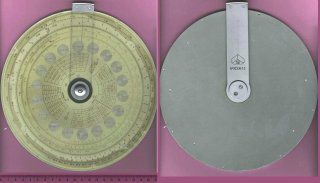
C01 USSR Artillery Ranging
|
USSR Soviet Artillery Ranging
Made in USSR
Front Scale:
tg, tg, 10K [Sin1-00, Sin0-10, 10K] Tables
Archive Photo - No longer in collection
|

Fesenthal FAA-8 Dead Reckoning Computer (c1940-1944) (Type E6B) AN-5835-1 U.S. Army Version WWII
ISRM 14.07.02.12





|
Felsenthal (Dalton) Dead Reckoning Computer - Type E6B
Military Version made of Black Anodized Aluminum
Made in USA by G. Felsenthal & Sons, cWWII
Invented by Philip Dalton, LTJG (1903 - 1941) Patent: 2,097,116
Front Scale: Distance Naut Miles, True Air Speed (Time Min, Hrs, Density Altitude, Air Temp )
Back Scale: Wind Correction Angle( True Heading )
Original owner/user (written on sleeve): R.F. Cassidy, Lt. Col. U.S. Army (See bio below)
Gifted by the Ed Millis Collection, Dallas, Texas.
From
Eyes of Artillery: The Origins of Modern U.S. Army Aviation in World War II (76MB PDF) by Edgar F. Raines, Jr.
R.F. Cassidy, Lt. Col (Later Major) is mentioned thropuight the text. [pg72] Robert F. Cassidy graduated from West Point in 1939 and was later a 1st Lt. in the 38th Field Artillery Battalion. Cassidy had washed out of primary
flight training, but as battalion reconnaissance officer he often flew with the Army Air
Forces observer squadrons. He knew every ripple of ground and every firing position
at the Leon Springs Reservation. He had, moreover, a genuine flair for fire direction. In
the comparative tests of observers before the arrival of the Army Air Forces squadron,
Cassidy established the best record.
Once airbornc in an L-4 he took an average of two minutes to bring fire on target. In contrast,
Army Air Forces observers first had to locate the firing battalion, which sometimes
proved difficult. They also did not always find the target. When they did, they required an
average of twenty-five minutes to adjust fire on the first target and an additional seven
minutes on another. The contrast in performance led the members of Flight B to make
Cassidy an honorary member of the Class Before One. [g124] Cassidy headed the new air-observation post concept with the 2nd Division, and took the Field Artillery pilot course and graduated on 6 March 1944 with Pilot Class 17. [pg252] In the Southwest Pacific Area, June 1944-September 1945, General Douglas MacArthur did not place an artillery air officer on his
staff, but during the last fifteen months of the war, he acquired two field army headquarters
that exercised operational control over ground units. Each of these contained an
artillery air officer - Maj. James McCord in Sixth Army and Lt. Col. Robert F. Cassidy in
Eighth Army. [pg288] Cassidy as, a Major, later became the Tactics
and Gunnery Division and then as a Lt. Col., the executive officer of the Division of Flight Training, a post he held until 6 May 1944, when he became the artillery air officer of U.S. Second Army with headquarters at Memphis, Tennessee. He co-authored athe manual on Technical and Tactical Training of the Field Artillery Sections 1983). Army Ground Forces Light Aviation, redesignated Army Aviation in 1949, owed its existence to the wartime exploits of thousands of air-observation-post pilots, mechanics,
and observers. These men had an opportunity to contribute to the war effort because of the
actions of ficld grade aviators such as R.F. Cassidy. Col. Cassidy (retired) was interviewed by the author during 1991.
Go to the Aviation Related Slide Rules Gallery to see all other military and commercial air navigation computers.
|


Japanese WWII Navy Bygrave Position Line Slide Rule For Navigation
REF
|
Japanese WWII Navy Bygrave Position Line Slide Rule For Navigation
Made in Japan - cWWII - Japanese copy of Bygraveslide rule
Bygrave scales. See Reference: "PositionLineSlideRules" By Ronald W.M. Riet.2008"
Archive - Ebay Photos
 In 1920 Capt. Leonard Charles Bygrave of the Royal Air Force patented a slide rule
design in which the scales formed helices wrapped around concentric telescoping
tubes. This allowed the scales to be made sufficiently long (nearly 8 meters) to obtain
the required calculational accuracy. Bygrave's method for solving the navigational
triangle involves splitting it into two right triangles and applying Napier's rules. The
required operations can then be reduced to a series of multiplications and divisions of
the trigonometric functions of the relevant angles. By suitable rearrangement these
can all be written in terms of cosines and cotangents, or equivalently secants and
tangents, The Bygrave slide rule scales are the logarithms of these functions. Versions
of the Bygrave slide rule were produced in Germany and Japan both for marine and
aerial use. In German versions, a mechanism that allowed the sliding scale tubes to be
locked to together during calculations was introduced.
Reference: "Bygrave Scales" by Robin G. Stuart, 2014
In 1920 Capt. Leonard Charles Bygrave of the Royal Air Force patented a slide rule
design in which the scales formed helices wrapped around concentric telescoping
tubes. This allowed the scales to be made sufficiently long (nearly 8 meters) to obtain
the required calculational accuracy. Bygrave's method for solving the navigational
triangle involves splitting it into two right triangles and applying Napier's rules. The
required operations can then be reduced to a series of multiplications and divisions of
the trigonometric functions of the relevant angles. By suitable rearrangement these
can all be written in terms of cosines and cotangents, or equivalently secants and
tangents, The Bygrave slide rule scales are the logarithms of these functions. Versions
of the Bygrave slide rule were produced in Germany and Japan both for marine and
aerial use. In German versions, a mechanism that allowed the sliding scale tubes to be
locked to together during calculations was introduced.
Reference: "Bygrave Scales" by Robin G. Stuart, 2014
|
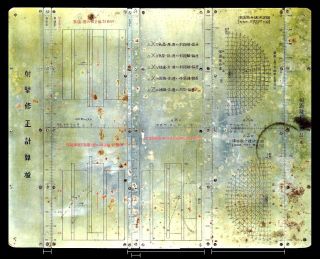
Japanese Gunnery Correction Slide Rule
REF
|
Japanese Gunnery Correction Slide Rule
Made in Japan - 1936 pre WWII
Front Scale:
tg, tg, 10K [Sin1-00, Sin0-10, 10K] Tables
Archive - Image from Duke University, Gessler Collection
A combination slide-rule/nomograph forcalculating ballistics corrections for temperature,
barometric pressure, vertical and horizontal wind and muzzle velocities. Probably used in
land-based Army operations in China. Weighing 16 pounds it measures 30x38x2.5 cm. It has
a thick wooden base, thick bronze or copper dovetail slides (with matching serial numbers 26),
and white brass faceplates. Three sliding scales are side-by-side, with a fourth sliding scale
inserted in the center slide.
|

Hemmi "Sun" Type 98 Maneuvering Slide Rule c1938
ISRM 14.09.25.01



Japanese Battleship YAMATO

Another of these slide rules was discovered in a bunker, located under a mountain behind the old Taura pyrotechnic factory, which manufactered torpedos during WWII, and stored them within. The buildings are currently part of the Maritime Self-Defense Force Yokosuka Zosamu depot and Akebono Machinery Co., Ltd. The bunker with its network of tunnels is not open to the public. See Yakumo's blog (in Japanese). Google will do a decent translation.
|
Hemmi "Sun" Type 98 Maneuvering Slide Rule
Made in Japan by "SUN"
Background: "Type 98" denotes that it was created in AD1938 (Koki or Jimmu Era 2598), which is 1938 in western calendars.
The type 98 Movement rule, is a polar coordinate measuring system and was designed to calculate tracking and range data between two moving ships (or objects) to, possibly, provide input to the Type 98 Hoiban and Shagekiban Low Angle Fire Control computer which was specially designed for the Yamato class of battleships (the Yamato and Murushi). It could also have been used as the primary calculator for the smaller guns that were not connected the the electromechanical computers on the main battery of guns. This slide rule could also have been used for Ship-to-Shore or Shore-to-Ship bombardement as well. Another feature of this slide rule is that the Maneuvering Board, with its rotating dial on the slide, can be used to determine course corrections and wind drift. Handy if the battleship Yamato or an aircraft carrier, is to launch an aircraft, it will calculate the best heading into the wind. Submarines, would also use a similar device to calculate intercept vectors. The design of this slide rule mimics the maneuvering board/tables of the Allies, designed in 1920, and is still in use today. The center of the dial is 'My' or 'Own' ship.
Scales and markings translated by Jiro Higuchi
Front Scale
Relative Coarse Angle // Speed of My Ship [ Speed of Standard Ship, Distance (Logarithmic Scale) nautical mile/Meters, ] Velocity \\ Velocity Ratio
Back Slide: Time Board, Distance by reading Hour/Nautical Mile or Minutes/Meters
Well: Velocity Ratio =>1, Angle of course alteration, Velocity Ratio =<1
Case: Naugahyde with military division "Air Armament 9/90"
Gift of Phillip Rodley, Upper Hutt, New Zealand
 Phillip Rodley Phillip Rodley
|

V2 Rocket Ballistic Ranging Slide Rule
Reference Image from Pennemünde Museum

Replica of V2 Rocket Ballistic Ranging Slide Rule
ISRM 13.00.00.81
Note from ISRM curator, Mike Konshak, who is certified to build and fly high powered rockets:
On the V-2 Rocket slide rule, all the scales are a variation of High vertical climb
(maximum altitude), maximum range, burn closing speed. The V2 ballistic missile would shut
off its motor at some point in its flight (burn closing speed) which was the maximum velocity
at that point, which was determined by it s inertial guidance system. This would vary based
on the desired range. At that point it went from the boost phase to the coast phase and begin
slowing down due to parasitic drag and fell (still very fast) to its intended target. It was
was not very accurate as it only went in the compass direction it was told to go. Full cutoff
determined the range. This slide rule was not very different from other artillery calculators.
The replica was made by the Curator from the image.
|
V2 Rocket Ballistic Ranging Slide Rule - c1942
Made in Germany - Heeresversuchsanstalt Peenemünde (Army Research Center Peenemünde)
Scales: Interpretation provided by Dr. Klaus Schug, as follows:
From distance from Pennemünde to London is about 950 KM or almost 600 miles. This would be the
Maximale Reichweite = 950 KM. Its maximum vertical height was between 50 to 60 miles
(80 to 95 KM) for long-range targets. This would be the senkrechte Steighöhe = say 90 KM.
I. zur senkr Steighohe - Vertical height in meters. Using 9.0 or 90,000 meters = 90 KM as the
heigth for reaching London from Peenemünde to London
II. zur Maximale Reichweite - Using 90 KM (9x10*4) on scale I , then scale II would read
about 7000 kg/m*2 = Ballistische belastung = 5163.2 lb.ft of load or stress on the rocket
III. senkrechte Steighohe - Looks like this scale was only for very short distances up to
80 KM using the top of scale IV as the distance desired and then looking at III to see
how high up the rocket had to go to reach the distances on the top of scale IV.
IV. Maximale Reichweite - using this scale with III gave the maximum distance for the
height in scale III.
V. zur max. Reichw. - Using the bottom of the scale, scale V, to hit longer distances,
say 950 KM to hit London, yields on scale V.
VI. Brennschlussgeschwindigkeit - Yields a end of burn velocity 900 m/sec to reach
London or a target at 950 KM.

V2 Rocket at Pennemünde
Archive - Image from Pennemünde Museum
|

Graphical Firing Table M24 No.7674035 Rule No2, Shell HE, M48

Graphical Firing Table M24 No.7674037 Rule No3, Shell HE, M48
Graphical Firing Tables for M24 75mm Howitzer
ISRM 18.04.06.62
|
Graphical Firing Table Slide Rule M24
75mm Howitzer Shell HE, M48
Made in USA - 1944-1953 U.S.Army for the M24 Chaffe Tank
Scales: Range, Elevation, Drift, etc
Gift of the Leroy Hausler Collection
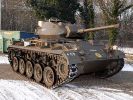

M24 Chaffee moves on the outskirts of Salzburg, May 1945


Correction Tables insert 7674039
|

Graphical Firing Table M24 No.7674033 Rule No. 1
Graphical Firing Tables for M24 75mm Howitzer Shell HE, M41A1
ISRM 22.07.06.06
|
Graphical Firing Table Slide Rule M24
75mm Howitzer Shell HE, M41A1
Made in USA - post WWII, 1944-1953 U.S.Army for the M24 Chaffe Tank
Scales: Range, Elevation, Drift, etc
Gift of Cindy Tate. Victor B. Tate Collection

Correction Tables insert 7674039
|

U.S. Military 76mm Howitzer Artillery Set
ISRM 03.00.00.55
|
U.S. Military 76mm Howitzer Artillery 2 SR set
Made in USA - 1952 (Korean Era)
Scales: Range, Elevation, Drift, etc
|

Soviet-LFAI Artillery
REF S552
|
Soviet-LFAI Artillery
Made in USSR
Front Scale:
1:50000M, 1:25000M // β, N² [Sin, S&T, Tg, N ] NQ+1,
L
Back Scale: [ Sin, S&T, Tg, N ]
Back: Position and spotter formulae
Multiple hairlined Cursor |

LFAI Soviet Military Dual Circular
ISRM 13.00.00.08
|
Soviet Military Dual Circular - 1957
Made in USSR by LFAI, Leningrad
Left Scale: 10000 meter (Sin)
Right Scale: 10000 meter (Tg)
Back: Position and spotter formulae
Actual application unknown at this time
|

Royal Ordnance 81mm Mortor Ranging Slide Rule
ISRM 18.09.17.55
|
Royal Ordinance 81mm Mortor M252 M821 M889 HE Ranging Slide Rule - ©1986
Royal Ordnance Ammunition LTD. Series 1. 1989
19200 9354443/4, 1220-01-215-9410
Made in UK by Blundel Harling (BHL)
Range 10000 meter (Elevation)
Gift of Donald Bachelor Collection
 The Watervliet Arsenal M252 81mm mortar is a crew-served, medium weight mortar which is highly accurate and provides for a greater range of 5,935 meters [3.68 miles] and lethality than the previous 81mm mortar. The M252 system consists of the M253 Cannon (tube), M177 Mortar Mount, M3A1 Baseplate, and M64A1 Sight Unit.
The Watervliet Arsenal M252 81mm mortar is a crew-served, medium weight mortar which is highly accurate and provides for a greater range of 5,935 meters [3.68 miles] and lethality than the previous 81mm mortar. The M252 system consists of the M253 Cannon (tube), M177 Mortar Mount, M3A1 Baseplate, and M64A1 Sight Unit.
|

Vickers MK I (Aust) W.H.H..303 M.G. Slide Rule
ISRM 21.08.21.01
|
Vickers MK I (Aust) W.H.H..303 Machine Gun Slide Rule
Made in UK. Made of cast aluminum with duralium S.S. For MK VII Ammunition.
Front Scale:
V.I. Metres To Yards [H.I.] Angle in Degrees | Range on Sights, Range Correction [ Range to Troops, Angle Required in Degrees ] Range for Wind in Yards, Line Correction.
, CI, C ] D, L
Back Scale Inch= 1 mile // Wind: [Wind 20 MPH: Head in mins, Range] Tables, Length of Cord forGraticule Purposes = 24 in [ True Base ] \\ Scale Yards
Note: Space on back for writing using a grease pen.
Acquired from Billy O'Toole,. Australia
 Royal Australian Regiment of the 3rd Battalion operate a Vickers gun during fighting near Chipyong-ni during the Korean War, February 1951
Royal Australian Regiment of the 3rd Battalion operate a Vickers gun during fighting near Chipyong-ni during the Korean War, February 1951
|

Vickers MK III W.H.H. 1940 .303 M.G. Slide Rule
ISRM 21.08.05.01
|
Vickers MK III W.H.H. 1940 .303 Machine Gun Slide Rule,
Made in UK Made of solid wood. For MK VII Ammn.)
Front Scale:
V.I. Metres To Yards [H.I.] Angle in Degrees | Range on Sights, Range Correction [ Range to Troops, Angle Required in Degrees ] Range for Wind in Yards, Line Correction.
, CI, C ] D, L
Back Scale Inch= 1 mile // Wind: [Wind 20 MPH: Head in mins, Range] Tables, Length of Cord forGraticule Purposes = 24 in [ True Base ] \\ Scale Yards
Gift of Phillip Rodley of Upperhutt, New Zealand.



1st photo:The British Army in France 1940:
Troops from 2nd Battalion Middlesex Regiment, 3rd Division, training on the Vickers machine gun at Gondecourt, 21 March 1940. Imperial War Museums 2nd Photo:Vickers Machine Gun Slide Rule on hip of British Seargent in its carrying case (3rd Photo - Australian War Memorial).
|
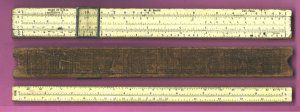
Lawrence 505_U.S. Navy
REF S495
|
Lawrence 505_U.S. Navy
Made in USA - Peru, Ind. (Lawrence)
Painted wood body
Front Scale:
A [ B, CI, C ] D, K
Back Slider
[ S, L, T ] Back: Conversion Chart
|

REF Lawrence - DeYOE Slide Rule, U.S. Army for Artllery Ranging |
Lawrence - DeYOE Slide Rule, U.S. Army for Artllery Ranging
Made in USA by Lawrence
Front Scale:
E-Mils [ R or H, R or dH ] UOE
Back: Not Shown
Archive - Scan donated by David Rance collection. Sassenheim, The Netherlands
|

Pickett Model 14 US Military Artillery Ranging (1959)
ISRM 18.04.06.83
|
Pickett Model 14 US Military Artillery Ranging (1959)
Made in USA - Round Black Logo, Stamped curved braces, Grooved flat lens.
Front Scale:
LL1+/-, LL2+/-, A [ B, T Cot, ST, S Cos,
K, C ] D, LL3+/-, LL4+/-
Back Scale:
Opposite angle Deg, Deg, Mils, Mils
[ Apex angle, Tan CoTan, Sin-Tan, Sin CoSin,
Base C ], Distance D, A
Gift Of Leroy Hausler Collection

|

Pickett Model 14 US Military Artillery Ranging (1962)
ISRM 12.04.22.01
|
Pickett Model 14 US Military Artillery Ranging (1962)
Made in USA
Front Scale:
LL1+/-, LL2+/-, A [ B, T Cot, ST, S Cos,
K, C ] D, LL3+/-, LL4+/-
Back Scale:
Opposite angle Deg, Deg, Mils, Mils
[ Apex angle, Tan CoTan, Sin-Tan, Sin CoSin,
Base C ], Distance D, A
|

US Navy Calculator For Vertical Aerial Photography, MIL-C-19729
ISRM 15.03.18.01
|
US Navy Calculator For Vertical Aerial Photography, MIL-C-19729
Made in USA by Fesenthal Instrument Co., Mfg Part Number FNA-82B U.S.
Front Scale:
Air Speed, %Overlap (Minutes, Hours, Density Altitude, Air Temp., Pressure Altitude
Back Scale:
Feet On Ground, Scale,Focal Length, Exposure, Ground Speed, etc(Feet on Negative, Altitude)
Gift of Aron J. Davidson
Aron writes: "I was an engineer for the Navy (Civil Service)for almost twenty years, and then another twenty five or so as a contractor. I spent a big chunk of my time working on R&D of tactical airborne photographic reconnaissance systems. There really isn't much of a story to go with this slide rule. It was primarily for operational use in mission planning, which I rarely got involved in, but someplace along the line it wound up in my desk drawer; and I'm a bit of a packrat." Aron gave his granddaughter a Pickett slide Rule that he used.
|

Union Instruments MIL-C-4318-B Type A-1
ISRM
|
Union Instruments MIL-C-4318-B Type A-1
Made in USA by Pickett
Front Scale:
L, A, DF [ CF, CIF, T, S, C ] D, DI, K
Back Scale:
Ground Size Meters, Feet, Ground Speed, [Image size, Cycling Time, Focal
Length ] Altitude
 USAF Manual 8.69Mb
USAF Manual 8.69Mb
|

P232 Pickett N700-T USAF Aerial Photo Type A-2
|
Pickett N700-T USAF Aerial Photo Type A-2
Made in USA for the USAF
Front Scale:
L, A DF [ CF, CI, T, S, C ] D, DI, K
Back Scale:
Ground Size Meters, Feet, Ground Speed, [Image size, Cycling Time, Focal
Length] Altitude
 USAF Manual 8.69Mb
USAF Manual 8.69Mb
|
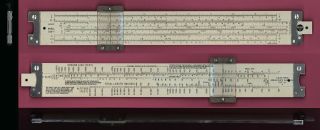
Pickett N520-T USAF Aerial Photo
MIL-C-4318-B Type A-1
ISRM 14.11.04.01

|
Pickett N520-T USAF Aerial Photo - MIL-C-4318-B Type A-1
Made in USA by Pickett. Aluminum stock.
Front Scale:
L, A, DF [ CF, CIF, T, S, C ] D, DI, K
Back Scale:
Ground Size Meters, Feet, Ground Speed, [Image size, Cycling Time, Focal
Length ] Altitude
Original owner used this in Rotorau, New Zealand, assumed to be part of the Royal New Zealand Air Force.
Gift of Phillip Rodley, Upper Hutt, New Zealand.

 USAF Manual 8.69Mb
USAF Manual 8.69Mb
|

USAF Type A-1 Aerial Photo
ISRM 04.09.30.01
|
USAF Type A-1 Aerial Photo - c1950
Made in USA for Astrodyne by Precision Scale Co. (founded by Art Eckel)
Front Scale:
L, A, DF [ CF, CIF, T, S, C ] D, DI, K
Back Scale:
Ground Size, Ground Speed, [Image size, Cycling Time, Focal Length ]
Altitude
 USAF Manual 8.69Mb
USAF Manual 8.69Mb
|
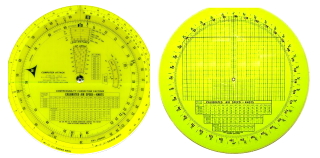
Air Navigation Attack Computer Type CPU-73A/P
REF
|
Air Navigation Attack Computer Type CPU-73A/P (9 inch Diameter)
Made in USA by Allegheny Plastics, Inc (APAF 53). Other maker: Felsenthal Instruments.
Note: Government contract No. F34601-80-C-1560, NSN 6605-00-435-1481 MIL-C-83856 (USAF)
Front Scale:
Turn Radiuis 45° Bank, Turn Radius 30° Bank (Target TAS, Interceptor TAS Minutes-Seconds, Lead Distance, LOP Angle, Temperature, Air Speed Table.)
Back Scale: Compass Rose, Wind Correction, Calibrated Air Speed Table.
Archive - Not in collection

|

Crichlow Circular (Artillery) Slide Rule (1936)
ISRM 04.09.27.02.D1 (In Display) |
Crichlow Circular (Artillery) Slide Rule
Designed by Robert Crichlow (1936). 12in (25cm) Dia Cardboard disc - One-sided
Front Scale:
A(1/sinA), B(1/cosA), C(Tan Cot), D(1/sin), E, F(Squares)
Solutions of Triangles
Per Brian Bourchers: This design was developed for the US Army coastal artillery in the
pre WWII period.. Notice that the outer scale goes to 6400 as there are
6400 mils in a circle under the military system.In artillery work, all angles were given in the mil system, with 6400 mils to a full circle, 1600 mills to a right angle, and so on. The outermost scale was a simple scale of 6400 mils, allowing the slide rule to be used as a circular protractor. The remaining scales moving from the outside to the center were simply labeled A through F. See The Crichlow Circular Slide Rule by Brian Bourchers
|

Nucearule 6in Dia 1949
ISRM 23.05.11.03


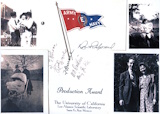
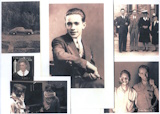
|
Nucearule 6in Dia 1949
Made in U.S.A. by Nuclear Instrument and Chemical Company
Note: 1949 Scale Set. No 1/e on LL02 and LL03. No SRT. No DI .Modern logo on right. Patents and model numbers on edge.
Front Scale: Activity, Counts/Minute Number of lives, Coincidence Loss(%), Resoluition Time (Microseconds)
Back Scale: Register Reading, Scale Factor, Probability (%), Fractional Error, Counts Per Minute, Time (Minutes).
Original Owner: Walter Charles Miller Ph.D
Gifted by his daughter, Sara M. Beagan and Peter Beagan.
 Walter Charles Miller (1918-1989), originally from South Bend, Indiana, was a nuclear physicist who was a scientist on the Manhatten Project in Los Alamos, New Mexico from 1944-1945..
He was on the team that developed the first nuclear bombs, Big Man and Little Boy.. His daughter Sara M. (Miller) Beagan was born in Los Alamos. He received his B.S.from St. Joseph's College, Philadelphia in 1940; his M.S.from the University of
Notre Dame in 1942. His Physics Dissertation was: A Study of the Continuous X-Ray Spectrum by Means of Nuclear Excitation..
He became a professor of Physics at Notre Dame from 1948-1981 and was the Physics Department Chair beginning in 1975.He helped construct the tandem accelerator.
See his Dietzgen 1776 Redi-Rule in the Dietzgen gallery
Walter Charles Miller (1918-1989), originally from South Bend, Indiana, was a nuclear physicist who was a scientist on the Manhatten Project in Los Alamos, New Mexico from 1944-1945..
He was on the team that developed the first nuclear bombs, Big Man and Little Boy.. His daughter Sara M. (Miller) Beagan was born in Los Alamos. He received his B.S.from St. Joseph's College, Philadelphia in 1940; his M.S.from the University of
Notre Dame in 1942. His Physics Dissertation was: A Study of the Continuous X-Ray Spectrum by Means of Nuclear Excitation..
He became a professor of Physics at Notre Dame from 1948-1981 and was the Physics Department Chair beginning in 1975.He helped construct the tandem accelerator.
See his Dietzgen 1776 Redi-Rule in the Dietzgen gallery
|

Radiation Counter Laboratories (RCL) Slide Rule
ISRM 23.05.11.05
|
Radiation Counter Laboratories (RCL) Slide Rule (1949)
Made in USA by Perrygraph Slide Charts. for Radiation Counter Laboratories, Chicago, Illinois.
Front Instructions: Standard Deviation, Coincidence Correction, Radioactive Decay, and Exponential Absorbtion.
Front Scales: A [ B ] C, D [ E ] F
Back Instructions: Mass Thickness, Conversion Factors.
Back Scales: G [ H ] I, [ Energy in MeV, Range in Mg/Cm2 AL.
Original Owner: Walter Charles Miller Ph.D
Gifted by his daughter, Sara M. Beagan and Peter Beagan.
|

US Armed Forces R&D Reliability Computer
ISRM 18.08.01.01
|
US Armed Forces R&D Reliability Computer
Made in USA by Naval Explosive Ordanance.Disposal Technology Division.
Front Instructions: Reliability and Confidence for one shot Devices,
Front Scales: No. of Failures, Confidence Factor, Mass Thickness, Conversion Factors., Total Tests, Standard Deviation, One-sided Distribution, Two-sided Distribution.
Back Instructions: Reliability and Confidence for Continuous Operation,
Back Scales: Confidence Level, No. of Failures, Failure Rate, Reliability, MTBF, Time
|

REF Radiac Nuclear Yield Calculator Set ABC-M28A1 - Disk One

REF Radiac Nuclear Yield Calculator Set ABC-M28A1 - Disk Two
|
Radiac Nuclear Yield Calculator Set ABC-M28A1
Made in USA - NATO number NSN6665-00-130-3616, 4-1/2in Dia. plastic
Scales:
TIME OF ENTRY, ENTRY-EXIT TIME AFTER BURST, DOSE-RATE (RADS/HOUR), DOSE (RADS), TRANSMISSION FACTORS,
YIELD-STABILIZED CLOUD BOTTOM (KT), STABILIZED CLOUD BOTTOM OR TOP OF ELEVATION ANGLE,
ALIGN FLASH-TO-BANG TIME WITH ELEVATION ANGLE, READ YIELD ON APPROPRIATE SCALE UNDER POINTER,
DISTANCE TO GROUND ZERO (KM), FLASH-TO-BANG TIME (SECONDS), YIELD FROM ILLUMINATION TIME,
FIREBALL ILLUMINATION TIME (SECONDS).

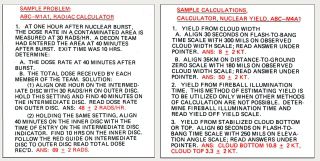
Carrying sleeve, sample problem card
Archive - BajaRon photos placed on ebay
|

Rand R-1380-PR Damage Probability Computer
ISRM 21.08.07.02
|
Rand R-1380-PR Damage Probability Computer (1974)
Made in USA for the U.S. Air Force.
Front Scales: Yield, Weapon Radius, Single shot Damage Probability, K-Factor Adjustment
Back Scales: Yield, Weapon Radius, Single shot Damage Probability, K-Factor Adjustment
Gift of William Lisowski




|

BRL Radiac No1 Radiation Exposure
ISRM 21.08.07.01
|
BRL Radiac No1 Radiation Exposure (1951)
Designed by William Orr (1951), BRL Mod/NSN Nr.:6665-99-911-0060 made for British & Canadian Governments.
Note: There is a second PINK disk missing. See it HERE (David Rance Collection).
Front Scales: Dose, Exposure
Back Scales: Yield, Weapon Radius, Single shot Damage Probability, K-Factor Adjustment
Gift of William Lisowski

|

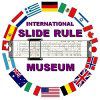 HOME
HOME





































































































 USAF Manual 8.69Mb
USAF Manual 8.69Mb





















